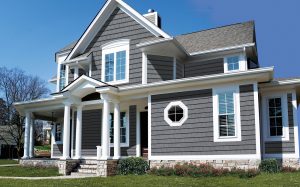It takes less than 10 seconds for someone to form an impression about a house. One of the most important factors in that impression? Color.
And with a lifespan of 10 to 15 years or more, siding and accent color choice is important.
“When selecting colors, follow the 60-30-10 rule of decorating,” advises color expert Trisha Wagner, senior product manager at Boral Building Products. “Sixty percent of your color will be siding; then your accent, which may be the trim, will be near 30%; and, finally, 10% will go into shutters or another element such as a stone façade.”
When looking at a home, think about what you want to see first and where you want to have the biggest impression.
Here are general rules and factors to consider when choosing and combining colors:
Work With Home Style and Period
To achieve the right look and feel, it’s important to understand the limitations of a home’s style and choose colors that align with the architecture and time period.
For a home with natural-finish cedar siding, for example, a more neutral trim and shutters will help maintain a traditional Colonial style, while bolder accent colors such as green or brown will give it a Craftsman-like look.
Take Cues From Existing Design Elements
For homes with existing stone or brick or those looking to add this element, Wagner offers this tip: To highlight or make the stone stand out, pair with a paint color that incorporates minor undertones from the stone. This will help draw it out and give a more dynamic appearance. Conversely, to make the stone or brick blend in, find a siding color that is more similar in tone.
Further tie these elements into a home’s look by matching the trim to the grout color of the stone or brick.
 Complementary colors in the siding and stone help the stone stand out without one element overwhelming the other.
Complementary colors in the siding and stone help the stone stand out without one element overwhelming the other.
Consider the Role of Nature and Lighting
Consider how landscaping will contrast and complement the look of a home. Houses with mature landscapes and shrubs with vibrant greens and other colors will draw the eye down. Be aware of what colors you or the homeowner will plant and how that relates to the colors you’re selecting for the home.
For homes that don’t have a lot of landscaping, consider brighter siding. For those with a denser landscape, you may want to consider darker colors for more contrast.
Landscaping can also influence lighting if a home is heavily shaded by trees or natural topography. Wagner advises to look at the direction the home faces and where the sun hits at various times of day to understand how the color may change.
 On the 2016 Fine Homebuilding ProHome, the entry area offered the perfect place for a pop of bold color, modernizing the look without taking away from the farmhouse vibe. It also provides a focal point since the home has limited landscaping.
On the 2016 Fine Homebuilding ProHome, the entry area offered the perfect place for a pop of bold color, modernizing the look without taking away from the farmhouse vibe. It also provides a focal point since the home has limited landscaping.
Consider What’s Trending
For the last five years, shades of gray have been the most popular choices for a home’s exterior. Homeowners inspired by the versatile neutral are frequently selecting varieties and combinations like green-gray, greige, and blue-gray.
Dark, rich jewel tones, such as sapphire blue, are another common selection for home exteriors. Colors in this family are typically paired with white trim, particularly on the ever-popular Craftsman-style homes.
For the indecisive homeowner or buyer, Wagner says neutral bases and black and white accents are a safe option that will stand the test of time.
Another growing trend on new construction home exteriors has been mixing textures, such as combining shake and traditional siding with brick and stone for a variegated look.
 Gray is a trendy choice that never goes out of style and pairs perfectly with crisp white trim.
Gray is a trendy choice that never goes out of style and pairs perfectly with crisp white trim.
Avoid Common Mistakes
The easiest way to avoid color mistakes is to consult the color wheel.
“It’s the same color wheel you played with in kindergarten,” Wagner says. “There are still complementary and contrasting colors, and that should be your ultimate guide.”
But you have a lot of flexibility, she adds, with the variety of tones available.
Before committing, get sample pieces of the siding colors being considered. Have your buyers put them up for a few days—perhaps on the weekend when they can see in the light at multiple points across the day—to see how they look.
 When in doubt, black and white is always a classic combination.
When in doubt, black and white is always a classic combination.
In the end, “personal preference is the ultimate guide,” Wagner says. “A home’s color is highly personable and a definition of the homeowner’s style, so give it the time and attention it needs.”


